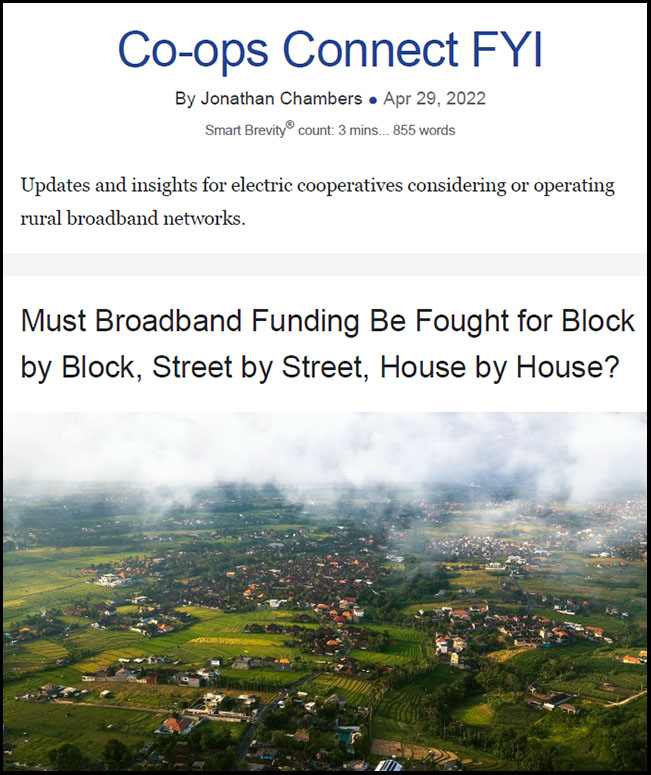Must Broadband Funding Be Fought for Block by Block, Street by Street, House by House?
April 29, 2022
For the past two weeks, I’ve written about persistent poverty counties, focusing on those that are not only impoverished but unserved by broadband.
Let’s take a deeper dive into one such area: Bienville Parish in Louisiana and its effort to improve broadband.
- According to the Census Bureau, 29.5% of the population lived below the poverty line in 2020.
- Between 2015 and 2021, AT&T received nearly $200 million in public funds from the FCC’s Connect America Fund to improve internet service in Bienville and other rural areas of Louisiana.
Once again, the public paid for steak and got baloney.
So:
- Working with Bienville Parish, we applied for funding from the Louisiana GUMBO program to build a fiber network.
- As with most programs, we had to identify areas that are unserved by at least 25/3 Mbps internet service.
FCC Data: Broadband Availability in Each Census Block
FCC data on service availability shows that most of the parish is unserved.
- In the red-colored areas above, no ISP reports the availability of 25/3 Mbps or better.
- Of the 13,638 people living in Bienville, 11,663 lack 25/3 Mbps service.
Why it matters:
Read that sentence again, but replace “25/3 Mbps” with “electric” and then imagine the difficulty in alleviating persistent poverty in Bienville Parish.
NTIA Data: Speed Test Data
Recently, the new NTIA Administrator bragged on NTIA’s mapping tools, which use speed test data from tens of millions of tests.
- Since the FCC’s maps tend to overstate the level of service, we used NTIA’s maps in the Bienville GUMBO application.
- Why it matters:
According to NTIA’s maps, using speed test data, the red areas have less than 10/1 Mbps service and the light/olive green less than 25/3 Mbps service. The bright green areas are the only served areas.
Taking It Further: Individual Sworn
Statements
The Bienville community collected more than 400 sworn statements from Bienville residents attesting to their lack of high-speed, reliable internet. (The addresses are shown in the NTIA map above as white dots.)
- Ironically, the lack of broadband service made collecting the attestations more of a challenge, as traditional methods like email were less useful.
- Fortunately, a committed local resident single-handedly spearheaded a solution to collect the statements more easily.
Slam dunk, right? Maps, speed test data, sworn statements.
Unfortunately, no.
- Internet service provider Suddenlink filed a protest of this GUMBO application.
- The protest claims nearly half of the GUMBO-eligible locations in the parish, specifically the Town of Arcadia, are already adequately served with broadband service through Suddenlink.
Rebutting The Challenge
Even using data supplied by the FCC, NTIA, Ookla, M-Lab, and residents of the county, a single challenge had to be countered with additional evidence.
- We matched addresses provided by Suddenlink asserting availability of broadband with the sworn statements of the people living at those addresses.
- The rebuttals were made by residents who attested to having “…no broadband service available to my household location or the only service available is satellite or cellular or the broadband provider speeds are less than 25/3 Mbps”.
The Big Picture
Much has been said about the new mapping effort by the FCC to determine the absence of broadband down to the level of the housing unit.
This is an endeavor already years in the making, the results of which won’t be known until next year.
And: $42.45 billion in public spending is being held up while we all wait.
Rural America waits. That’s how the Infrastructure Act was written.
NTIA waits. “That timeline depends quite a bit on when the FCC maps are in shape to be available,” according to NTIA Administrator Davidson, whose agency is responsible for the allocation of broadband funds.
In the meantime:
NTIA won’t stand behind its “great maps.” When you use NTIA maps for NTIA programs, NTIA won’t accept the data as valid.The FCC won’t stand behind its broadband maps, which were developed over the course of the past decade.
States often won’t stand behind their maps. State maps are usually produced by consultants who also sell services to applicants for funding (no conflict there).
The bottom line:
Proving the need for broadband funding is left to applicants, block by block, street by street, house by house.
- It will get worse with the new FCC maps because now the disputes can occur at every address.
- Whoever thinks that the FCC maps will be accurate in the very first iteration has never worked with FCC data.
- Whoever thinks that household level data is necessary to determine whether rural America needs funding for broadband has never lived in rural America.
Oh yeah, it was Congress that made that policy. Congress influenced by incumbents. Incumbents who argue against “overbuilding” and benefit from a delay in competition.
All while rural America waits.
We should find out next month whether Bienville residents will be able to get sufficient funding for broadband.
Next week, I’ll explain why NTIA doesn’t really need to wait for new FCC maps before it begins allocating funds to states.
